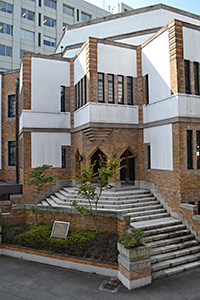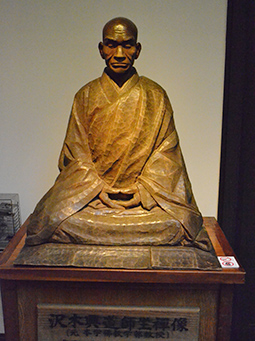 |
Focus features two in-depth reviews each month of fine art, architecture and design exhibitions and events at art museums, galleries and alternative spaces around Japan. The contributors are non-Japanese art critics living in Japan. |
|
|
 |
 |
 |
Meditating on Meditation: Komazawa University's Museum of Zen Culture and History
Michael Pronko |
 |
|
 |
|
|
|
The unusual exterior of the Kounkan makes a striking contrast with the other campus buildings that now surround it.
|
Many college campuses house old buildings, but few if any have a Zen Museum. At the very center of Komazawa University's campus in Setagaya, Tokyo sits a stolid gem of a building that is home to the fascinating Museum of Zen Culture and History. Komazawa University was a seminary for monks of the Soto sect of Zen Buddhism for three centuries from 1592 until it became a modern university in 1882.
A course on Buddhism is still a requirement today, so students must go to the museum for lectures, self-study, and perhaps a bit of meditation, especially if they decide to major in Zen Buddhism. Students wander quietly through the building (the museum is free for everyone), working on assignments, heading to the basement classrooms and workshop areas, or just looking, curious to see what's inside.
|
| The main Buddhist altar in the central symbolic space. On either side of the Buddha are statues of the founders of Soto Zen, Dogen and Keizan. Paper fortunes are available in front of the Buddha for the many students who visit. |
The main hall housing the permanent exhibits is a large octagonal room with a stained glass skylight that lets in more light than any temple, so you can easily see the massive Buddhist altar and the statues of the Buddha and founders of Soto Zen. The exhibits are simple and clear, as one might expect, displaying the living space, clothing, and musical instruments used inside Zen temples. The feeling, however, is not historical, but present and practical. Seeing the exhibits up close makes Zen come alive.
|
 |
|
|
|
A statue of Zen Master Kodo Sawaki, seated in the proper meditation position. Instructive and artistic goals meld into one.
|
In the small rooms off the main octagonal hall, exhibits show the transmission of teachings of Soto Zen's two central figures, Dogen and Keizan, as well as the influence of Zen on the culture and arts of Japan. The explanations are mainly in Japanese. However, a small pamphlet in English covers the essential basics. Most interesting, though, is just to see the scrolls, statues and other elements of temple life.
Many of the written and visual items come from the Komazawa University Library, which houses a rich collection of Buddhist materials. Drawing on the library's collection, as well as on donations from other temples and archives, the museum has special exhibitions that change several times a year. The current exhibition, on display until November 16, 2013, offers handwritten records and ancient maps from the library that describe earthquakes going all the way back to the first written records of Japan.
|
| Many of the musical instruments used during Zen Buddhist ceremonies are on exhibit. Each instrument is used for specific purposes and at specific times in the ceremony. |
That exhibition goes together well with the building itself, known as the Kounkan, which was erected in 1928 as a recovery project after the Great Kanto Earthquake of 1923. Built with earthquake resistance in mind, the Kounkan incorporates an eclectic mix of styles, motifs and structures designed by architect Eizo Sugawara.
The influence of Frank Lloyd Wright, who lived and worked in Japan, and who Sugawara worked with, can be found in many aspects of the building, such as the light, airy feeling of the interior, the extensive outdoor lighting and windows, and an emphasis on daily functionality. The building housed the university library for many years, as evidenced by an old card catalogue saved for the digital generation. The building was designated a Historical Building by the Tokyo Metropolitan Government in 1999.
|
| A display of the simple living and meditating conditions of Buddhist monks. Meals consist of rice, pickles, and a little seasoning. |
The open, tranquil atmosphere of the interior makes the museum a delightful place to sit and relax. Visitors may not have time to complete an entire Bachelor of Arts degree in Zen Buddhism, but at least they can explore a bit of the fascinating world of Soto Zen Buddhism. The oneness of practice and study, a central principle of Soto Zen, and at the university, is clearly manifest in the museum.
|
The lineage of Zen masters and important monks is detailed from the earliest days of Zen history to the present. Exhibits also explain the significant impact Soto Zen thought has had on Japanese society, history, and culture.
All photos by Michael Pronko, by permission of The Museum of Zen Culture and History.
|
 |
 |
Michael Pronko
Michael Pronko teaches American literature, film, art and music at Meiji Gakuin University. He has appeared on NHK, Sekai Ichiban Uketai Jugyo, and other TV programs. His publications include several textbooks and three collections of essays about Tokyo. He writes regular columns for Newsweek Japan, ST Shukan, The Japan Times, and for his own websites, Jazz in Japan and Essays on English in Japan. |
|
 |
|